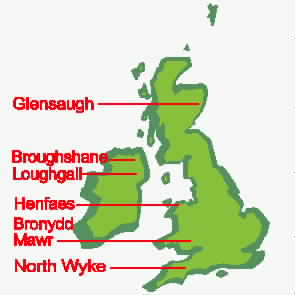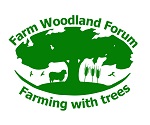 The Silvopastoral National Network Experiment was an early trial of agroforestry across the UK. Beginning in 1968, there were originally six sites involved in the trials:
The Silvopastoral National Network Experiment was an early trial of agroforestry across the UK. Beginning in 1968, there were originally six sites involved in the trials:
- Glensaugh/upland (MLURI FC)
- Broughshane/upland(DANI)
- Loughgall/lowland (DANI)
- Henfaes/lowland (UWB)
- Bronydd Mawr/upland (IGER FC)
- North Wyke/lowland (IGER FC)
The experiment officially ended in 2001. However, most of the sites are now retained on a care and maintenance basis. Routine measurements have been stopped but the management of the sites remains as close as possible to the original protocols. Subsequent research has been and continues to be conducted on some of these sites, utilising the unique resource of a mature UK agroforestry system.
The sites have a number of common treatments based on sycamore (Acer pseudoplatanus).
Sycamore was chosen originally because it has the potential to grow well over the wide range of sites represented in the Network:
- Sycamore agroforestry planted at 100 trees per hectare with sheep grazing;
- Sycamore agroforestry planted at 400 trees per hectare with sheep grazing;
- Sycamore Farm Woodland Control planted at 2500 trees per hectare with no grazing;
- Agricultural Control with no trees and sheep grazing.
Trees were individually protected in agroforestry treatments, but some sites have now removed protection as the trees matured.
Woodland Control trees were not individually protected but fences exclude grazing and browsing animals. There are three replicates of all treatments and controls.
The sites were managed to a common set of management protocols for the agricultural and forestry components:
Management of agricultural component -
- Plots were grazed by breeding sheep with lambs in season (breeds used are appropriate to individual sites);
- Ewes and lambs were turned out after lambing;
- Lambs were removed at weaning;
- Ewes were removed at the start of winter when pastures would be damaged by further grazing;
- Pastures were maintained at common seasonal sward height for upland and for lowland sites by "putting and taking" sheep based on weekly measurements of sward height;
- Grazed plots are based on ryegrass (Lolium perenne) dominated permanent pastures;
- Grazed pastures received 150 kg nitrogen per hectare per annum in 4 applications;
- Phosphorus and potassium were applied as required by local circumstances.
Management of forestry component -
- Trees are planted in a square grid pattern;
- Trees in agroforestry plots are individually protected by shelters or net guards;
- A 1m diameter spot was kept weed free for 3 years after planting;
- Both broadleaves and conifers are pruned to create a knot-free bole;
- Conifers are also pruned to minimise the sail effect of the canopy;
- Pruning is based upon an agreed protocol.
A common standard set of measurements was made at all sites.
Reference: Sibbald A.R., Eason W.R., McAdam J.H. and Hislop A.M. (2001). The establishment phase of a silvopastoral national network experiment in the UK. Agroforestry Systems 53(1): 39-53.
